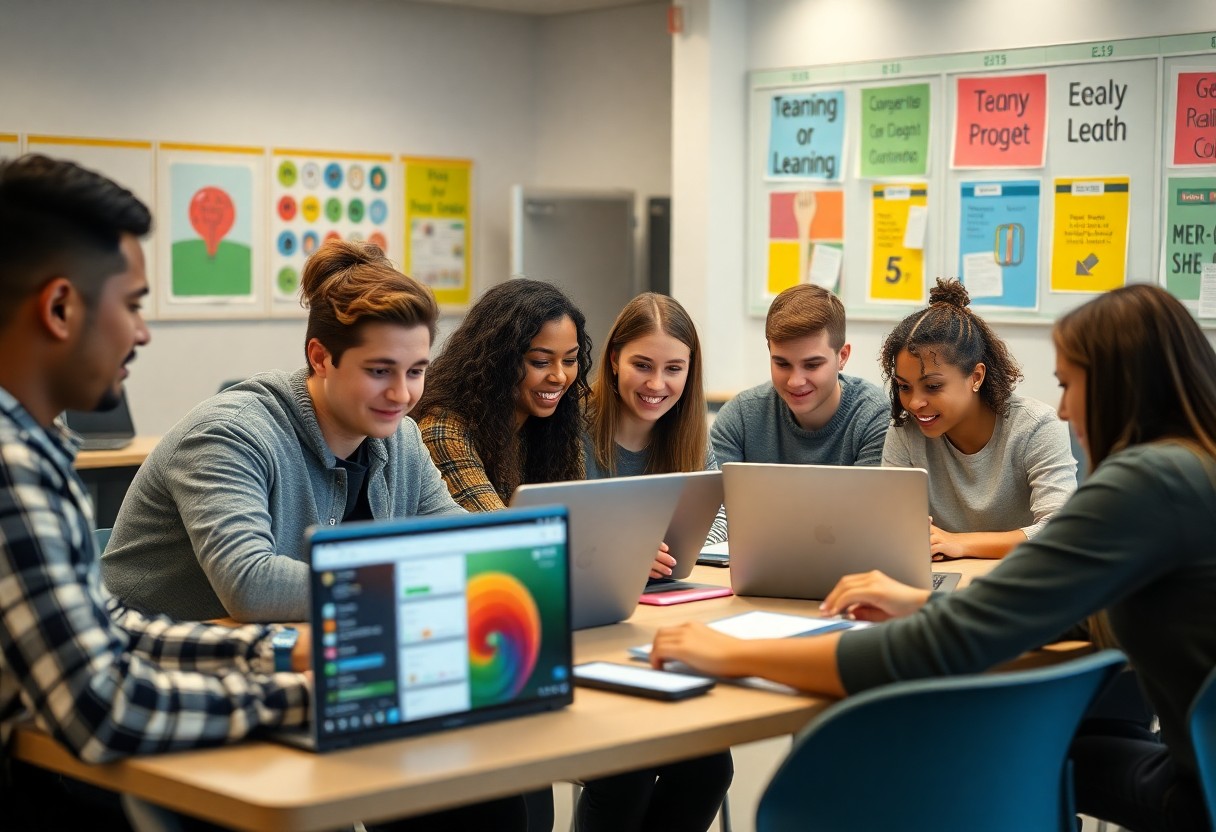Online education has transformed the way you engage with students, extending the learning experience beyond traditional course boundaries. By fostering a sense of community, you can enhance student motivation, encourage collaboration, and nurture meaningful connections. In this blog post, we will explore effective strategies to help you create an engaging online learning environment that keeps students involved and invested, even after the course concludes. Discover how to leverage tools, activities, and communication techniques to build a thriving online learning community that benefits both you and your students.
Foundations of Online Learning Communities
Before you investigate creating an engaging online learning community, it’s important to understand the foundations that will support its growth and sustainability. These foundations encompass shared values, effective communication, and a sense of belonging among members. By establishing a robust framework, you can foster collaboration and enhance the overall learning experience, benefiting both you and your students beyond the classroom.
Defining Learning Communities in Digital Spaces
Communities in digital spaces are groups of individuals who connect around shared interests or goals, fostering an environment where collaboration, support, and knowledge exchange thrive. In the context of online learning, these communities create opportunities for you and your peers to engage deeply with course content, enhancing both understanding and retention. The digital format provides unique avenues for interaction, breaking geographical barriers and enabling diverse voices and perspectives.
Key Elements of Successful Online Engagement
At the heart of effective online engagement lies a blend of interaction, inclusivity, and purpose. Engaging your students goes beyond traditional teaching methods, incorporating diverse formats such as forums, video conferences, and social media interactions to enrich the learning experience. By creating spaces that encourage participation and valuing every member’s input, you can cultivate a community that thrives on collaboration and shared learning.
Communities require ongoing interaction and meaningful connections for successful online engagement. You should aim to create opportunities for feedback, discussions, and networking among participants. Integrating multimedia resources, interactive assignments, and regular check-ins can keep the community vibrant and engaged. Fostering an environment of inclusivity where everyone feels comfortable sharing their thoughts will encourage participation and deepen relationships. Ultimately, your active involvement and responsiveness can significantly enhance the collective learning experience within the community.
Creating an Inclusive Virtual Environment
Some key elements of building an inclusive virtual environment include fostering open communication, celebrating diversity, and ensuring that every voice is heard. As you design your online learning community, it’s vital to create spaces where students feel valued and respected, enhancing their engagement and participation beyond just the course material.
Establishing Community Guidelines
The establishment of clear community guidelines is fundamental in shaping an inclusive environment. By outlining expectations for respectful interactions and collaboration, you empower your students to engage meaningfully while promoting a culture of mutual respect and understanding. Your guidelines should be easily accessible and regularly revisited to encourage ongoing adherence.
Fostering Cultural Sensitivity and Diversity
On the path to a successful online learning community, fostering cultural sensitivity and diversity should be a priority. Being aware of different backgrounds and perspectives enriches the learning experience for everyone involved.
Considering the diverse backgrounds of your students, it’s important to integrate multicultural perspectives into your learning materials and discussions. Encourage students to share their experiences and viewpoints, as this not only enhances cultural awareness but also leads to more dynamic interactions. Providing opportunities for students to collaborate on projects that celebrate diversity can further strengthen community ties and create a more supportive environment for all learners.

Interactive Tools and Technologies
Even in a virtual space, the right interactive tools and technologies can transform your online learning community. Utilizing a diverse range of platforms not only facilitates communication but also fosters engagement and collaboration among students. By incorporating these tools, you can enhance the learning experience and create a vibrant community that extends beyond the confines of a traditional course.
Synchronous and Asynchronous Communication Platforms
One of the key elements of a successful online learning community is the use of synchronous and asynchronous communication platforms. These tools allow you to interact with your students in real time or provide them with resources and discussions they can engage with at their convenience. By offering a blend of both, you cater to various learning preferences and ensure that every student feels included.
Collaborative Learning Technologies
With collaborative learning technologies, you can facilitate group projects, brainstorming sessions, and peer-to-peer feedback effectively. These technologies empower your students to connect, share resources, and learn from one another, promoting a sense of community and teamwork.
It is important to select collaborative tools that fit your objectives and your students’ needs. Platforms like Google Workspace, Microsoft Teams, or Miro enable real-time collaboration and seamless communication, allowing students to work together on tasks regardless of their location. With features such as shared documents, discussion boards, and video conferencing, these technologies bring your students closer together, creating an engaging and supportive learning environment. By implementing these tools, you can encourage active participation and help your community thrive.

Student Engagement Strategies
Not all online learning environments facilitate meaningful connections between students and their peers. To foster a vibrant learning community, you must be intentional about the strategies you employ for student engagement. By actively integrating diverse approaches, you can enhance the overall learning experience, ensuring that your students not only acquire knowledge but also build lasting relationships within the course.
Peer-to-Peer Learning Activities
Behind every successful online class lies opportunities for peer-to-peer learning activities. Encouraging students to collaborate through discussion forums, group projects, and study groups can help them develop a sense of camaraderie. This interaction not only improves their understanding of the course material but also allows them to gain different perspectives and insights from their classmates.
Gamification and Interactive Assessments
Along with traditional teaching methods, incorporating gamification and interactive assessments into your course can significantly increase student engagement. By adding elements like badges, leaderboards, and quizzes that involve competition, you can motivate students to participate more actively in their learning journey. These strategies can create a fun and dynamic atmosphere where students feel excited to learn.
Interactive assessments can transform passive learning into an engaging experience. By utilizing tools such as quizzes, polls, and simulation games, you encourage your students to apply what they have learned in real-time scenarios. This approach not only reinforces knowledge but also allows students to receive instant feedback, fostering a growth mindset. Ensuring these assessments are varied and enjoyable enhances student engagement, making the learning process more interactive and effective.
Building Sustainable Connections
After establishing a vibrant online learning community, focus on building sustainable connections that foster long-term engagement. Encourage open communication and collaboration among students, creating a sense of belonging that extends beyond the virtual classroom. By prioritizing relationship-building activities and interactive content, you facilitate ongoing student engagement and ensure that their educational experience remains dynamic and meaningful.
Mentorship Programs
Against the backdrop of traditional education, mentorship programs stand out as personalized pathways for growth. By pairing students with experienced mentors, you provide valuable insights and guidance that enhance their learning journey. This one-on-one approach helps build trust and encourages mentees to ask questions, seek advice, and discuss challenges in an intimate setting.
Alumni Networks and Professional Development
The formation of alumni networks is an important step in creating lasting connections beyond graduation. These networks offer a platform for former students to share experiences, seek job opportunities, and participate in professional development activities that align with their career aspirations.
Programs designed for alumni can include workshops, networking events, and access to exclusive job boards. By facilitating these opportunities, you not only support your graduates but also create a thriving ecosystem that benefits current students. This interconnected network fosters collaboration, allowing alumni to mentor newer students, share industry insights, and contribute positively to the community as a whole.
Measuring Community Success
Keep track of key indicators that reflect the health of your online learning community. Analyzing engagement levels, participation rates, and student feedback can help you gauge the effectiveness of your community-building strategies. Regular assessments will empower you to identify areas for enhancement and reinforce the sense of belonging among your students.
Assessment Methods and Metrics
Between surveys, discussion forum activity, and peer interactions, various assessment methods enable you to capture your community’s dynamics effectively. Utilize metrics like participation frequency, content contributions, and overall satisfaction ratings to collect actionable data that guides your approach to fostering a supportive environment.
Continuous Improvement Strategies
Any successful online learning community evolves based on feedback and insights gathered from its participants. To maintain engagement, you should regularly review your strategies and adapt your approach to meet the changing needs of your students.
For instance, consider conducting monthly feedback sessions to solicit students’ opinions on community activities and resources. Use this information to refine your strategies, such as tweaking discussion topics or introducing new engagement tools. By embracing an iterative process of reflection and adjustment, you ensure that your online learning community remains vibrant, relevant, and supportive of your students’ growth.
To wrap up
So, as you venture into building your online learning community, focus on fostering engagement that extends beyond traditional course boundaries. By creating an inclusive environment where students feel valued and connected, you can enhance their learning experience and encourage collaboration. Utilize interactive tools, regular communication, and opportunities for peer-to-peer support to keep your community thriving. Your efforts in cultivating these relationships will ultimately lead to a more enriching educational journey for everyone involved.

